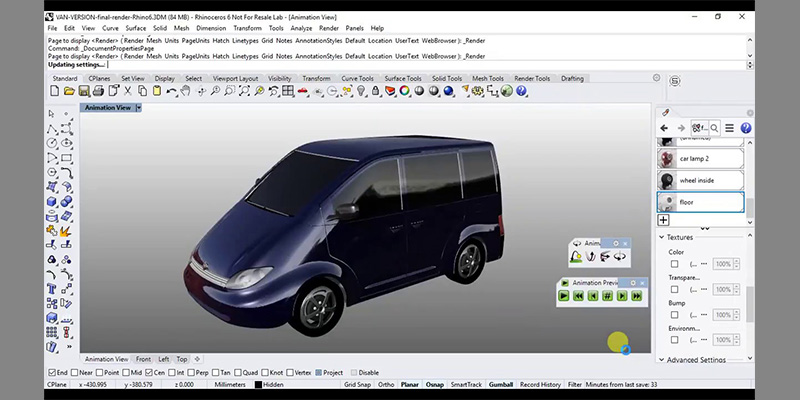Fusion 360 VS Rhino, these two software are both powerful and come with different features and functionalities that are used in many industries. So, what are the differences between them? And which one is better for you, based on the tools and features they offer?
Brief Background:

Fusion 360 VS Rhino
starting with Fusion 360, which is a 2D/3D CAD software developed by Autodesk that was officially launched as a commercial product in 2013.
This is why many experts call it a young program. This software has found its balance between engineering and 3D design. It is a user-friendly and versatile software that enables integration of design processes, from design and simulation to manufacturing. It is a new and simplified approach to parametric modeling, which Autodesk renews with each new release.
Fusion 360 meets the expectations of entrepreneurs, engineers, and designers in 3D CAD.

Rhino, commonly known as (Rhino 3D) is a 3D drawing software developed by a company founded in 1980. It allows you to model a wide variety of shapes – without limiting creativity. This computer-aided design software can also be used for 2D drawings, but it is not the main purpose of developing it. Whether it is rapid prototyping or production, there are many advantages offered by this program.
What are The Uses of Fusion 360 VS Rhino?

Fusion 360 is used to create 2D and 3D designs. It allows you to work using different types of modeling such as parametric modeling, surface modeling, and polygonal modeling. To take advantage of the possibilities offered by this technology you need to combine the tools from the three modes to reach the best results. Many tools for manufacturing are integrated into Fusion, allowing for Planning, Generation of tool paths, assembly management, and simulation.
The special thing about Fusion 360 is that it utilizes cloud technology in a way that not many other CAD programs do.

Rhino is a CAD software with a multitude of modeling tools, which allow you to model a wide variety of shapes – without locking up and limiting creativity. It can create, edit, analyze, document, render, animate, and translate NURBS curves, surfaces, and solids with no limits on complexity, degree, or size.
Rhino also supports polygon meshes and point clouds. Its accuracy and flexibility make it possible for students to explore and build their ideas without having to spend much time learning CAD.
Modeling and Design Differences

Fusion 360 can be used for different types of modeling, from technical details to organic surfaces. The first is parametric modeling, which is based on 2d sketches forming a closed network of curves (Profile). The relationships between sketch elements and dimensions are defined in the sketch and reflect the design intent. The second is surface modeling. It contains surface creation tools (extrusion, sweep, etc.) that allow surface creation based on sketch profiles. In this environment, a closed solid can be decomposed into its constituent surfaces. The third is polygonal modeling, which allows: the creation of organic or ergonomic shapes in the software’s sculpt space, creation of a Tspline from primitives (boxes, cylinder, etc.), creation from profiles (closed curves) by extrusion, sweeping, and the possibility of transforming a surface created from the Model environment or Patch into a T-spline to edit the shape.
Long story short, Fusion 360 comes with many tools that should always be combined to make the process of designing products easier and give better results.

Rhino, on the other hand, uses the curve modeling technique, with non-uniform rational B-splines (NURBS or Non-Uniform Rational Basis Spline). This technique involves performing modeling by working on curves rather than connecting polygons and vertices. You can, therefore, create your surface in three dimensions by making changes on curves. This type of modeling allows us to optimize the number of facets making up the surface of the object. This modeling technique is the most precise out there.
Rhino provides access to a wide range of tools to develop your projects, whatever your field. You will find all the basic tools, transformation tools, points, curves, or surfaces.
Your 2D creations can also benefit from the strengths of Rhino, thanks to the features of Make2D. You can indeed develop technical drawings and illustrations, thus communicating your ideas more easily. Adapted to additive manufacturing, the advantages of Rhino are not limited to this sector.
Animations and Simulations
Fusion 360 VS Rhino?

Fusion 360 supports keyframe animation, so you can make all kinds of animations for your assemblies, like engines, gearboxes, and more. Using the Transform tool, you can move your components to animate them in a timeline.
Just keep in mind that the organization of your components matters here, and complex animations should probably be done in another tool specialized in animation. In general, Fusion 360’s animation features are best-suited for simple visualization.

Rhino provides limited tools for creating animations of your models. These animation tools move only the camera and the sun. As opposed to fusion 360 it includes no tools for animating objects. When rendering an animation you will have to Render the frames to create a series of still images.
These still images can be combined into an animation file. It does not include tools for compiling the frames into animation files, but there are many other products that specialize in this process.
Rendering
Fusion 360 VS Rhino?

Both Fusion 360 and Rhino offer their users a rendering option to create renders that can give a realistic view of the product and a clearer vision of a conceptual design than a plotted drawing.
In Fusion 360, you just have to head over to the model or patch icon and hover over it to get a flyout that lets you select render. in the rendering workspace, you will see the background and model change a little as it is being optimized for visualization. You will also notice the toolbar has tools to control materials, environment, and quality of rendering.
You need first to apply materials to your design with the workflow, and you can give specific material attributes to your model. For example, you can set your solid bodies to be “made of” marble, wood, various metals, glass, and more before changing the Environment Style with a choice of 8 different styles and be able to rotate the light source to control where highlights show up on your design.
Fusion 360 gives you the right to choose the type of rendering process, it can be quick, normal, or advanced. Rendering time can vary depending on assembly size, reflectivity, transparency of parts, and a few other variables.

Rhino is also capable of helping you create high-quality renderings, so you can enhance your presentations as well. This software lets you create color renderings with lights, transparency, textures, and bump maps.
Objects will be rendered white if you do not set a rendered color, reflection, texture, transparency, or bumps. The attributes are assigned in the Properties panel, Material section. The process for rendering scenes consists of three basic steps; add lights, assign materials, and finally rendering. To improve quality, repeat these operations until the image looks correct.
Their Use in Industries :

Fusion 360 is used in many fields and by many industries Electronics industry, furniture design, mechanical design, also by aerospace companies.
Rhino is primarily used in architectural industries, industrial design, jewelry, and design of fashion accessories. It is also used by transport designers and artisans because of the precision and possibility of creating free forms.
The Learning Curve:

For people who do have some experience with using CAD software, Fusion 360 and Rhino will not be complicated. But there are still some differences in the usability of the two products. Fusion 360 is not so difficult, it has a complete suite of 3D modeling tools, making it quite easy to create solid models. Moreover, this software is flexible, with a great push/pull tool allowing us to create great organic geometry and surfaces.
Rhino 3D is relatively easy to pick up, but you will still need some experience and practice to fully benefit from it. It provides many functionalities that may help its users to get better results.
Fusion 360 vs Rhino Pricing/Licensing:

In Fusion 360, as a hobbyist, student, you could qualify for a free license.
You can use Fusion 360 for free if you are a student or educator, in which case you can obtain a three-year subscription. You can also get a free license if you are engaged in a hobby or nonprofit business, and your revenue does not surpass more than 100,000 USD annually or using it for your projects outside of your primary business. If you do not fit any of the cases above, you can still have it with an annual subscription of $495/year (or $60/month).

When it comes to Rhino, the sixth version starts at $995.00, per user. They do not have a free version. Rhino 6 does not offer a free trial. The license to use the software is chargeable. But for previous versions for example Rhino 5 it has a free trial version that will get you the full software for 90 days.
Autodesk’s Fusion 360 is available both for Mac and Windows users. When it comes to Rhino, it is also available for both Windows and Mac.
Which One is Better?
Rhino is a CAD program used to create realistic models for specific fields previously mentioned, not for a simple plan or illustration 2D modeling. This is great when you want to construct a piece of accessory or construction objects. 2D drafting in Rhino can be very challenging; as it is made essentially for 3D designing.

Fusion 360 is great for mechanical or technical designs, but its ability to sculpt artistic 3d models is very restricted. It is business software rather than artisan software.
Finally, some CAD tools can be more needed in some sectors rather than others. That is why you should know that you cannot decide which one is better. You just need to understand and analyze the various options available in both software and then find out your business needs, budget, and skill levels which play an important role in deciding which software is better for you.































